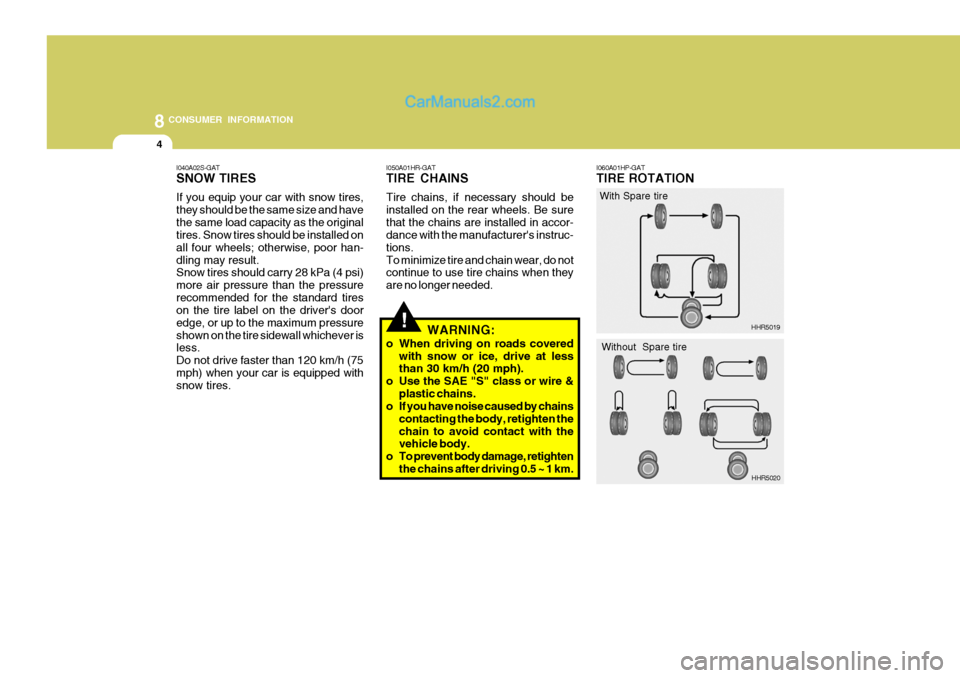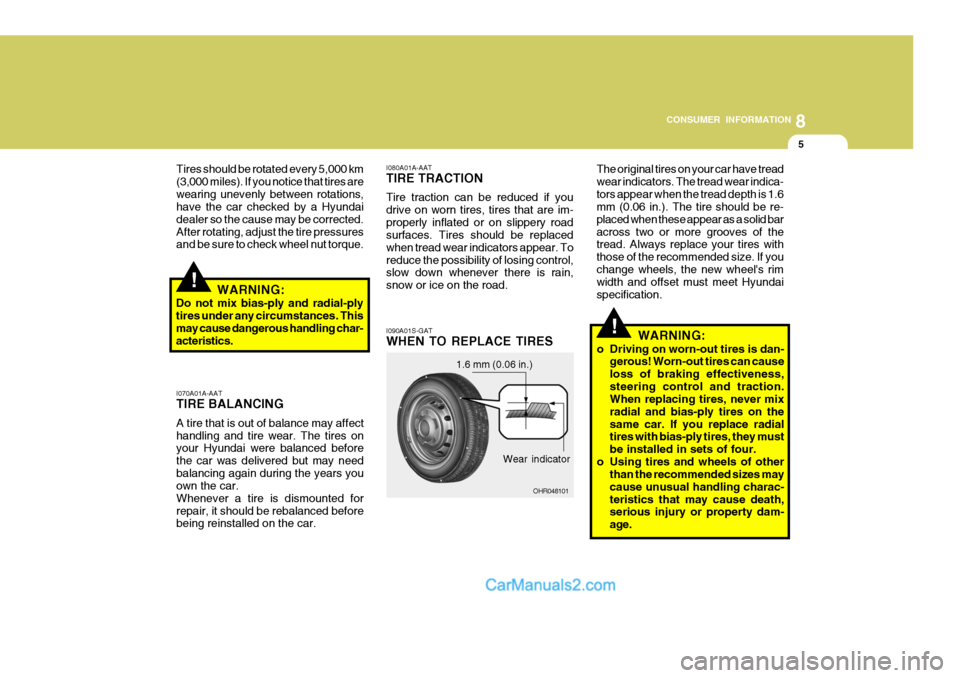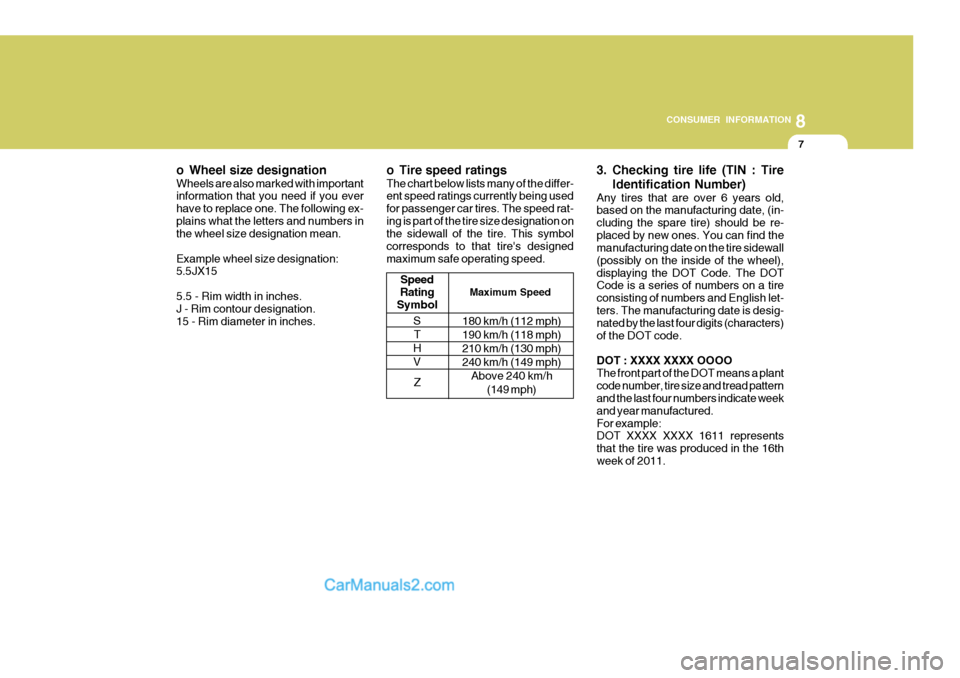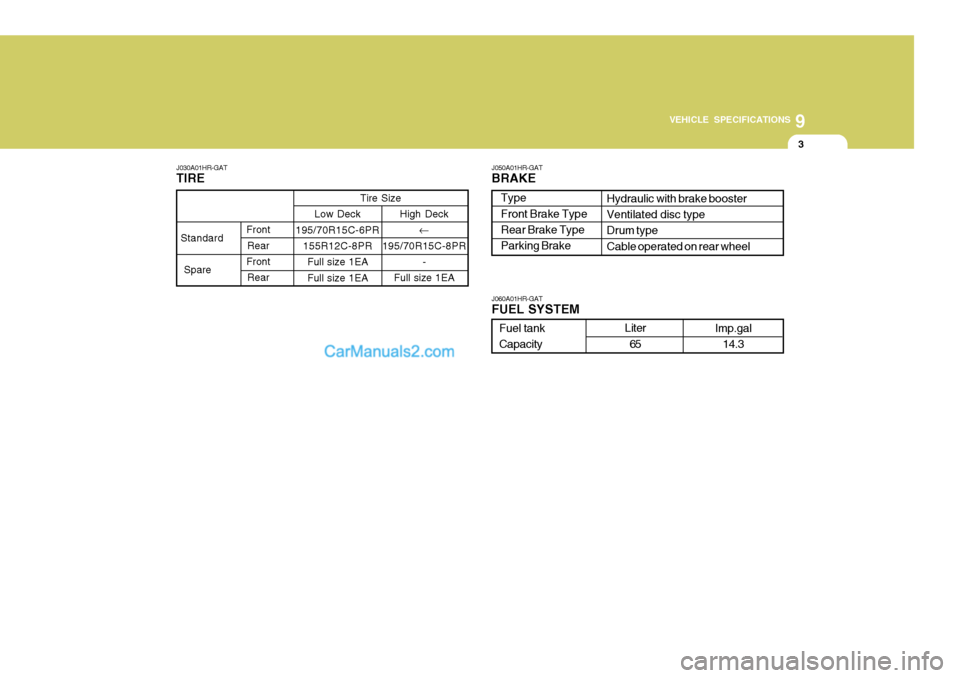wheel size Hyundai H-100 Truck 2012 Owner's Manual
[x] Cancel search | Manufacturer: HYUNDAI, Model Year: 2012, Model line: H-100 Truck, Model: Hyundai H-100 Truck 2012Pages: 217, PDF Size: 9.37 MB
Page 201 of 217

8CONSUMER INFORMATION
4
HHR5019!
I050A01HR-GAT TIRE CHAINS Tire chains, if necessary should be installed on the rear wheels. Be surethat the chains are installed in accor- dance with the manufacturer's instruc- tions.To minimize tire and chain wear, do not continue to use tire chains when they are no longer needed.
I040A02S-GAT SNOW TIRES If you equip your car with snow tires, they should be the same size and havethe same load capacity as the original tires. Snow tires should be installed on all four wheels; otherwise, poor han-dling may result. Snow tires should carry 28 kPa (4 psi) more air pressure than the pressurerecommended for the standard tires on the tire label on the driver's door edge, or up to the maximum pressureshown on the tire sidewall whichever is less. Do not drive faster than 120 km/h (75mph) when your car is equipped with snow tires. I060A01HP-GAT TIRE ROTATION
WARNING:
o When driving on roads covered with snow or ice, drive at less than 30 km/h (20 mph).
o Use the SAE "S" class or wire & plastic chains.
o If you have noise caused by chains
contacting the body, retighten the chain to avoid contact with the vehicle body.
o To prevent body damage, retighten the chains after driving 0.5 ~ 1 km. HHR5020
With Spare tire
Without Spare tire
Page 202 of 217

8
CONSUMER INFORMATION
5
!
!
I070A01A-AAT TIRE BALANCING A tire that is out of balance may affect handling and tire wear. The tires on your Hyundai were balanced before the car was delivered but may needbalancing again during the years you own the car. Whenever a tire is dismounted forrepair, it should be rebalanced before
being reinstalled on the car. I080A01A-AAT TIRE TRACTION Tire traction can be reduced if you drive on worn tires, tires that are im-properly inflated or on slippery road surfaces. Tires should be replaced when tread wear indicators appear. Toreduce the possibility of losing control, slow down whenever there is rain, snow or ice on the road. I090A01S-GAT WHEN TO REPLACE TIRES
Tires should be rotated every 5,000 km (3,000 miles). If you notice that tires arewearing unevenly between rotations, have the car checked by a Hyundai dealer so the cause may be corrected.After rotating, adjust the tire pressures and be sure to check wheel nut torque.
WARNING:
Do not mix bias-ply and radial-ply tires under any circumstances. Thismay cause dangerous handling char- acteristics.
Wear indicator
1.6 mm (0.06 in.)
OHR048101 WARNING:
o Driving on worn-out tires is dan- gerous! Worn-out tires can cause loss of braking effectiveness,steering control and traction.
When replacing tires, never mix radial and bias-ply tires on thesame car. If you replace radial tires with bias-ply tires, they must be installed in sets of four.
o Using tires and wheels of other than the recommended sizes maycause unusual handling charac-teristics that may cause death, serious injury or property dam- age.
The original tires on your car have treadwear indicators. The tread wear indica-tors appear when the tread depth is 1.6 mm (0.06 in.). The tire should be re- placed when these appear as a solid baracross two or more grooves of the tread. Always replace your tires with those of the recommended size. If youchange wheels, the new wheel's rim width and offset must meet Hyundai specification.
Page 204 of 217

8
CONSUMER INFORMATION
7
o Wheel size designation Wheels are also marked with important information that you need if you ever have to replace one. The following ex-plains what the letters and numbers in the wheel size designation mean. Example wheel size designation:
5.5JX15 5.5 - Rim width in inches. J - Rim contour designation. 15 - Rim diameter in inches. o Tire speed ratings The chart below lists many of the differ- ent speed ratings currently being used for passenger car tires. The speed rat-ing is part of the tire size designation on the sidewall of the tire. This symbol corresponds to that tire's designedmaximum safe operating speed.
3. Checking tire life (TIN : Tire
Identification Number)
Any tires that are over 6 years old, based on the manufacturing date, (in- cluding the spare tire) should be re-placed by new ones. You can find the manufacturing date on the tire sidewall (possibly on the inside of the wheel),displaying the DOT Code. The DOT Code is a series of numbers on a tire consisting of numbers and English let-ters. The manufacturing date is desig- nated by the last four digits (characters) of the DOT code. DOT : XXXX XXXX OOOO The front part of the DOT means a plantcode number, tire size and tread pattern and the last four numbers indicate week and year manufactured.For example: DOT XXXX XXXX 1611 represents that the tire was produced in the 16thweek of 2011.
Speed
Rating
Symbol Maximum Speed
180 km/h (112 mph) 190 km/h (118 mph)210 km/h (130 mph)240 km/h (149 mph)
Above 240 km/h (149 mph)
S
T
HV
Z
Page 209 of 217

9
VEHICLE SPECIFICATIONS
3
J030A01HR-GAT TIRE
Hydraulic with brake booster Ventilated disc type Drum type Cable operated on rear wheel
J060A01HR-GAT FUEL SYSTEM
J050A01HR-GATBRAKE
Type Front Brake TypeRear Brake Type Parking Brake
Front Rear Front Rear Tire Size
Low Deck
195/70R15C-6PR 155R12C-8PR
Full size 1EAFull size 1EAStandard Spare
High Deck �
195/70R15C-8PR -
Full size 1EA
Fuel tank Capacity Liter
65 Imp.gal
14.3